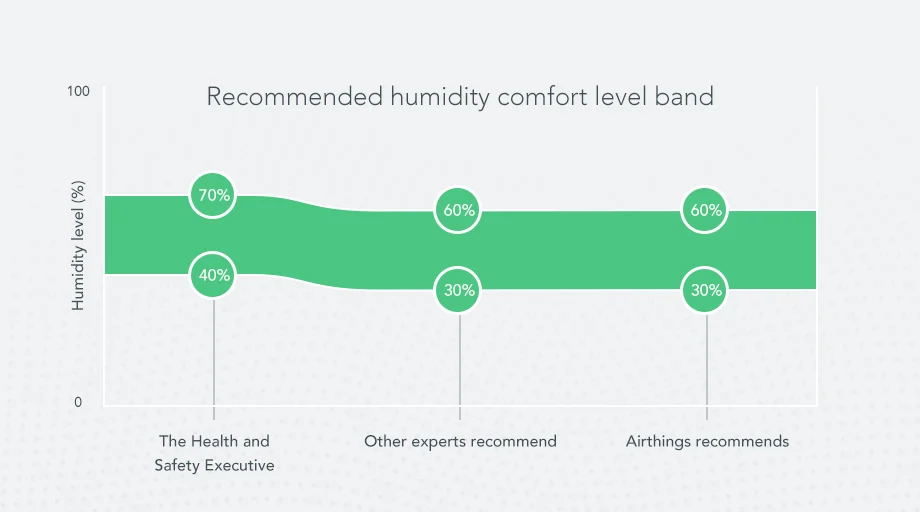How to prevent high humidity in your home
The good news is that you can take some simple steps to deal with high humidity in your home, with the help of good quality information about the humidity levels in your property.
The things we all do in our houses every day: washing clothes, taking baths or showers, cooking, and even breathing, generate moisture, but we can limit humidity problems in the home by minimizing this moisture and letting it escape.
Firstly, take steps to ensure that water can’t get into your home, by checking your roof and brickwork regularly, particularly after winter storms.
Make sure your property is properly ventilated. That could be as simple as cracking open a window, but make use of fans and air conditioning too. This is especially important in rooms like the kitchen, the laundry, and the bathroom. When you’re cooking, use the ventilation hood, and activate extractor fans in the bathroom or laundry.
Humidity causes fewer issues if your home remains properly and consistently heated. Try to maintain a relatively constant temperature, even if it means turning down the thermostat a little, but keeping the heating on for longer. As a result, there will be less opportunity for warm air to cool and cause condensation.
In addition, avoid drying clothes indoors, if you suffer from high humidity. Hanging wet towels or other items on radiators is a common practice that creates humidity as the moisture evaporates, increasing the risk of humidity damage in the home.
Finally, by installing indoor air quality monitors you will be alerted to any potential problems, and have historical data, so you can see where persistent issues arise. Humidity sensors are an essential part of any air quality monitor, as they provide a detailed understanding of potential issues regarding moisture in your home. Avoid problems and optimize conditions with minimum fuss.
How to fix high humidity in your home
So if you already know that you have high humidity problems in your home, what can you do about it? Many of the prevention measures are also effective in dealing with existing issues.
Ventilation is key, and the simplest remedy is often to open windows. A more lasting solution could involve installing air conditioning, to get air circulating through your home, which will carry the moisture away. Alternatively, a dehumidifier draws moisture from the atmosphere, causing humidity to drop.
If you don’t have effective extractor fans in bathrooms or laundry rooms, or the ventilation hoods in your kitchen aren’t working well, you may need to repair or replace this equipment. Make sure that washing machines and tumble driers are plumbed in properly, and vented so that moisture escapes as it should.
How low humidity damages your home
How low should you let humidity get in your home? As we’ve discussed previously, ideally the figure should not drop below 30%. At lower humidity levels, the effects can include dry or itchy eyes, dry skin, and infections spreading more rapidly.
Dry, low-humidity air also causes physical damage to the home. Wood contains a certain amount of water, in ideal conditions, and when it loses too much moisture in dry air it experiences shrinkage. This can result in serious damage to flooring and furniture, or shifting window panes. Low humidity can also generate excess static electricity, which sometimes affects electrical equipment and computers.
How to prevent low humidity in your home
To prevent low humidity in your home, you should find ways to add more moisture into the air. For example, you might want to leave a door open to let steam escape from the shower. Or you could choose to air-dry clothes indoors. You could turn down the heat or boil a pot of tea on the stove. Think about investing in some pot plants too as they release moisture into the air. All of these actions will increase the humidity in your home. But be careful you don’t overdo it, and end up with a problem of high humidity as a result.
How to solve low humidity in your home
If you have persistently dry air, you might want to consider installing air conditioning or a humidifier to get the conditions right. To make sure that you’re doing the right thing, and to avoid going too far and encouraging high humidity, it’s important to understand the air quality in your home.
An indoor air quality monitor will provide real-time and historical data on humidity, as well as other metrics, so you know exactly where problems exist and where they could potentially arise.
KEY TAKEAWAYS
- High humidity over 60% can encourage mold and mildew, and damage furniture, wallpaper, paintwork, floors, and brickwork.
- To help combat high humidity problems, heat your home properly, use ventilation, and keep moisture-creating activities to a minimum.
- Low humidity causes wood to shrink, which can damage furniture, floors, and window panes. It can also affect electronics.
- Heating and ventilation can help to control low humidity issues, while a humidifier stops the air from getting too dry.
- Using an indoor air quality monitor gives you detailed data on humidity, so you can deal with issues and avoid damage to your property.










.webp)


